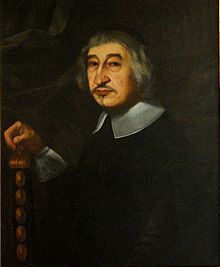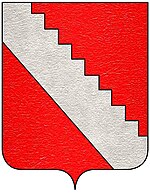Stjepan Gradic
Stjepan Gradić , Italian Stefano Gradi (born March 6, 1613 in Dubrovnik (Latin / Italian Ragusa ), † May 2, 1683 in Rome ), was a Roman Catholic priest , polymath and diplomat of the Republic of Ragusa at the Holy See .
Life
Gradić came from the city aristocracy of Dubrovnik. His parents were Miho Gradić, Senator (member of the Consilium Rogatorum ), and Marija geb. Beneša. His maternal uncle was Petar Beneša (ital. Pietro Benessa ) (1580-1642), vicar general in Dubrovnik, then Officials in State Secretariat of Urban VIII. In Episcopal rank . By Benešas mediation Gradić was 16 years old to Rome to the Collegio Romano , then studied at the University of Fermo and received his doctorate in 1638 at the University of Bologna for Doctor of Laws . He then continued his theological studies in Rome. After his uncle's death in 1642, he returned to Dubrovnik, was ordained a priest and became Commendatabab of the Abbey of St. Cosmas and Damian on the island of Pašman and a member of the Dubrovnik Cathedral Chapter .
In 1653, with the approval of the cathedral chapter, he returned to Rome, where he was active as a negotiator in matters relating to the Republic of Ragusa. He tried to get the post of first curator of the Vatican library , but initially received only one post in the State Secretariat.
With the election of Alexander VII as Pope in 1655, with whom Gradić was personally known through a circle of poets, his position in the Curia improved further. When Queen Christine arrived in Rome that same year, he was given the honorable assignment of the Latin welcome speech. In 1656 he was officially appointed representative of the Republic of Ragusa to the Holy See. In 1662 he was given the second position of curator of the Vatican library.
He has now been definitively released from his residence obligation in Dubrovnik, so that he could devote himself fully to his diplomatic, philosophical and poetic activities. A collection of his Latin poems had already appeared in a volume in 1660 with six other authors. His interest in physics and mathematics was also lively . Michelangelo Ricci dedicated his Exercitatio geometrica de maximis et minimis to him in 1666 .
In 1664 Gradić traveled with a delegation under Cardinal Flavio Chigi to Paris to ratify the Peace of Pisa . There he got to know, among others, Bossuet , with whom he remained in correspondence afterwards. After the death of Alexander VII in 1667 Gradić was given the honor of holding the Oratio de eligendo summo pontifice in front of the cardinals who had gathered for the conclave .
A turning point in Gradić's life was the earthquake of 1667 , in which his hometown Dubrovnik was completely destroyed and half the population, including almost the entire government, was killed. He became a key figure in the reconstruction, obtained emergency aid from the Holy See, sent architects and engineers home and took special care of the reconstruction of St. Mary's Cathedral . With the help of his extensive diplomatic relations, he prompted governments across Italy and Europe to provide financial aid and political support for the Republic against Venice and the Ottoman Empire .
A diplomatic mission to Venice in 1674 brought him valuable contacts in Florence with Antonio Magliabechi , Cardinal Leopoldo de 'Medici and Grand Duke Cosimo III. a. In the papal Orient policy , he advocated the recognition of Russian tsarism and an anti-Ottoman alliance of all Catholic and Orthodox princes. He promoted the church union .
Gradić was a member of the Paduan Accademia dei Ricovrati and from 1674 the Academy of Queen Christine . He dedicated his most important scientific work to the Queen, the Galileo- inspired Dissertationes physico-mathematicae quattuor , printed in Amsterdam in 1680 .
In 1679 Gradić stayed again in Paris and made the unsuccessful attempt to dissuade Louis XIV from his alliance with the Ottomans.
In January 1682 Gradić was succeeded Lorenzo Brancati di Lauria (1612–1693) as the first custodian of the Vatican library, which he had aspired to for thirty years. Encouraged by his learned correspondents and friends, he arranged for the purchase of numerous contemporary books regardless of their ecclesiastical and religious position.
After his death in 1683 Gradić was buried in the church of San Girolamo degli Illirici in Rome.
literature
- Tomaso Montanari: GRADI (Gradič), Stefano . In: Dizionario Biografico degli Italiani , vol. 58, 2002
Web links
| personal data | |
|---|---|
| SURNAME | Gradić, Stjepan |
| ALTERNATIVE NAMES | Gradi, Stefano; Gradius, Stephanus |
| BRIEF DESCRIPTION | Croatian priest, scholar and diplomat in Rome |
| DATE OF BIRTH | March 6, 1613 |
| PLACE OF BIRTH | Dubrovnik |
| DATE OF DEATH | May 2, 1683 |
| Place of death | Rome |

